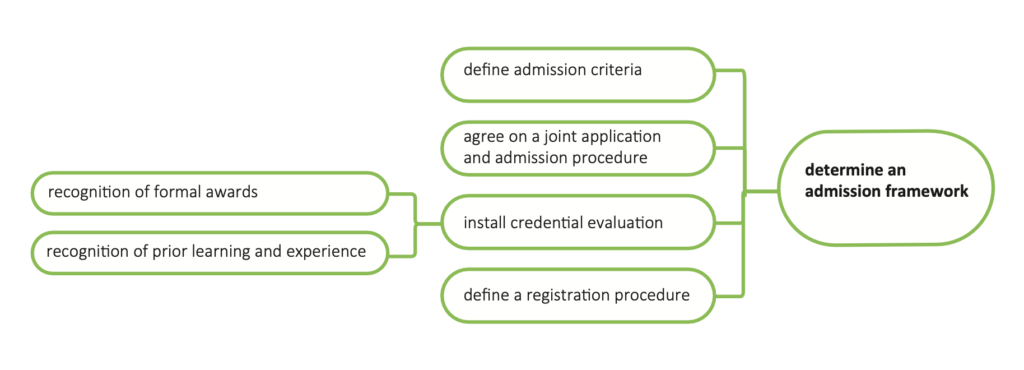
| The partnership has to establish an examination committee, consisting of academic representatives from all partner universities . The examination committee determines a joint admission framework, which includes: |
| Define admission criteria; |
| Agree on a joint application and admission procedure; |
| Install credential evaluation; |
| Define a registration procedure. |
Guidelines
Define admission criteria
Admission criteria for a micro-credential programme are determined by the programme team, taking into account several options:
Admission to the micro-credential programme can be open, meaning it is not dependent on formal requirements such as a diploma. The programme team may ask the learner to prove that he has already acquired previous competencies (knowledge, skills) necessary to successfully complete the programme by showing his CV or learning portfolio, formal
education awards, professional development certificates or work experience. On the basis of this, the programme team evaluates the student’s readiness for the study programme, advises him on admission and, if necessary, proposes a preparatory course unit or course unit.
Open admission is best suited to micro-credential programmes, which are intended to contribute to professional or personal development.
However, open admission is not always possible, for example if the study programme is a stackable module in a formal study programme. If necessary, the learner must be informed that he cannot valorise the micro-degree qualification for registration for a degree programme if he does not meet all (legal) prerequisites for this degree.
In the case of a post-bachelor or post-master micro-credential programme, the programme team can set the corresponding bachelor’s or master’s diploma as an admission requirement.
Agree on a joint student application and admission procedure
The programme team, chaired by the lead university, establishes a joint application and admission procedure for students. It meets on admissions whenever a cohort of new students enter the programme. The procedure must be transparent, fair and objective.
The programme team also ensures equality, taking into account the living conditions of students with special needs or different social backgrounds.
Install credential evaluation
Credential evaluation is only required if formal entry qualifications are required for the micro-credential programme. The programme team looks at previous qualifications or credits obtained at other (international) universities.
The programme team can also evaluate and formally recognize prior knowledge or experience taking into account to institutional rules and can award credits (ECTS) for this. This exempts the learner from parts of the micro-credential programme he intends to take. Most institutions rightly follow the rules of the ECTS Guide for this. The STACQ project has developed a credential evaluation tool for micro-credentials, including those containing only sparse certificate information (Nuffic, 2022).
Define a registration procedure
To receive credits and the joint qualification at the end of the programme, learners must be enrolled in each of the partner institutions. A learner can enroll in the programme at any partner institution, giving him a main registration for the entire programme and a secondary registration in the other institutions according to schedules worked out between the respective student administrations. This results in the capacity for each of the rectors or deans of the faculty to sign certificates. The costs associated with the registration are divided among the partners according to common rules (see section on business plan).
It is also possible for the student to sequentially enroll in a course at each of the partner universities as the programme progresses. This is administratively more complicated for the learner and for the programme team. The total fee that the student has to pay at the end will probably also be much higher.
next chapter: Determine examination regulations
previous chapter: Install a language policy
back to overview: Models and guidelines for the design and development
of a joint micro-credential programme in higher education
